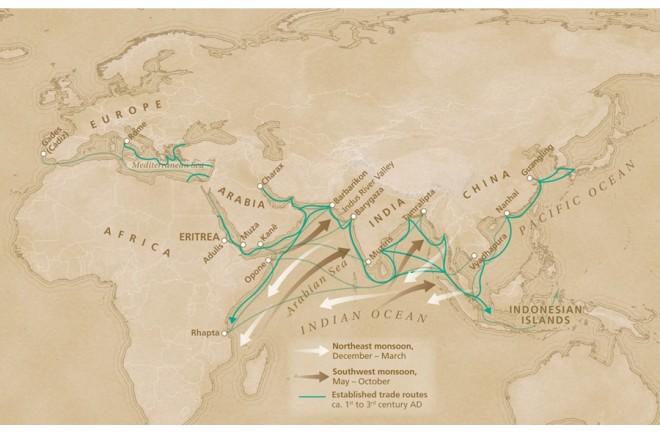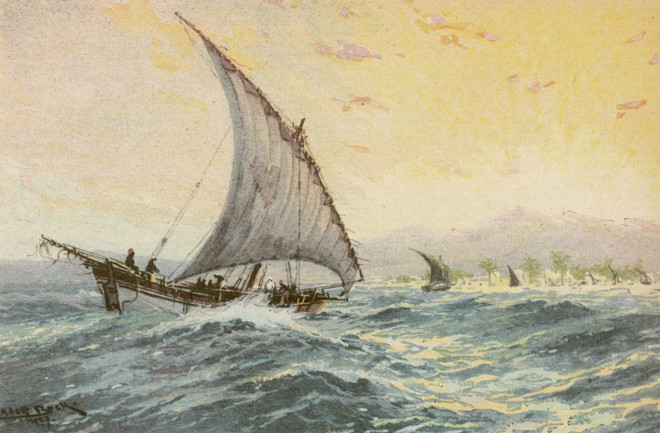
The Indian Ocean History is marked by maritime trade; commercial and cultural exchange perhaps date back at least nine thousand years.
Nikhil Chandwani
I recently took a firm decision to take up Masters in Archaeology (I am not a dropout anymore) and later a Ph.D. in the same subject with a specialization in the study of humans. However, what excites me most is the Evolutionary History of Oceans. Why? Because my Sindhi ancestors found success in trade and commerce due to the seas.
So, let’s explore the carrier sea – our Indian Ocean from the Land before Time in our article today.
Origin
India moved away from Antarctica around 66 million to 2.6 million years ago. This rapid motion ceased around 56 to 33.9 million years ago and was followed by an era in which little or no spreading took place west of the Ninety East Ridge (a mid-ocean ridge on the Indian Ocean floor). Australia separated from Antarctica during this period. The seafloor that formed during these separations created the Indian Ocean.
History
Unlike the Pacific and Atlantic, which blocked early travel, the Indian Ocean has connected people since ancient times.
The Out of Africa theory states that humans spread from Africa into mainland Eurasia. The more recent Coastal hypothesis instead suggests that humans spread along the southern Asia and Arabic Peninsula coasts. The spread and waves of migration of humans are made possible by the Indian Ocean. The first civilizations in the Indian Subcontinent, the Middle East, East Africa, the Malay World, South East Asia, and Australia; were interlinked due to migration made possible by the Indian Ocean.

The Indian Ocean History is marked by maritime trade; commercial and cultural exchange perhaps date back at least nine thousand years. Humankind evolved early on the Indian Ocean shore and was linked to the Hindu, Mediterranean, and Persian cultures. Fishing and Netting became a common practice nearer to the shore. Around this time, humans understood the difference between fresh water and saltwater (Ocean Water). Before 2000 BCE, however, cultures were only loosely tied to each other; bronze, for instance, was produced in Mesopotamia around 3500 BCE but remained rare in Egypt before 1600 BCE. During this era, short-distance sea interactions along its littoral margins developed into an all-embracing network. The origin of this network was not the achievement of a centralized or advanced civilization but regional and local exchange in the Red Sea, the Arabian Sea, and the Persian Gulf. Coast-bound ships moved goods between the Indus Valley Civilization in Ancient India and Egypt and the Persian Gulf.
Globalization of Food
Food globalization started on the Indian Ocean around 5100 years ago. Major African crops — pearl millet, sorghum, cowpea, finger millet, and bean — found their way to Indian Gujarat and Sindh during the Harappan (2000–1700 BCE) Era. Gujarati and Sindhi merchants emerged as the first explorers of the Indian Ocean as they traded African goods such as tortoise shells and ivory. Broomcorn millet found its way from Central Asia to East Africa, together with chicken and banana. Around 2500 BCE, sesame and black pepper, both native to Asia, arrived in Egypt.
Movement
The Indian Ocean’s calmer waters opened the regions bordering it to trade earlier than the Pacific or Atlantic oceans. The mighty monsoons also meant boats could easily move west early in the season, then wait a couple of months and return east. This enabled ancient Indonesian tribes to cross the Indian Ocean to migrate to Madagascar in 1 CE. In the 2nd Century BCE, Eudoxus of Cyzicus was the first Greek to traverse the Indian Ocean. During the 1st century CE, strong trade relations emerged between Roman Egypt and the Tamil kingdoms of the powerful Cholas, Cheras, and Pandyas in Southern India. The Chola Dynasty Navy was perhaps the best in the region with potent diplomatic and maritime force across Asia, with trade links extending from China to Arabia.
Medieval Era
Medieval Era in the Age of Indian Ocean Discovery involved missionaries spreading religion, colonial powers trading slaves, and settlement of new Islands. Arabic missionaries and merchants began propagating Islam around Africa by navigating via the Indian Ocean. The Portuguese explorer Vasco da Gama rounded the Cape of Good Hope during his first tour in 1497 CE and became one of the first known European to move to India. The Ottomans expanded into the Indian Ocean in 1510 CE with the Egyptian invasion under Sultan Selim I.
Early Modern Era
The Dutch East India Company establishment in the early 17th century brought a sad turn of events in the History of the Indian Ocean. It lead to an increase in the volume of the slave trade in the areas; there were around one million slaves in Dutch colonies during the 18th century in the Indian Ocean. The East India Company used slaves to construct forts, harbors, and churches in Réunion, Mauritius, Bali, and India. There were also numerous prison camps built by the colonialists and invaders across the Indian Ocean. This includes the Cellular Jail in the Andamans in India and Robben Island in South Africa. Here, exiles, prisoners, forced laborers, POWs, merchants, and people of various faiths were forcibly united. Due to this, on the islands of the Indian Ocean, a trend of creolization (Creolization is the process through which creole cultures and languages emerge) appeared.
________________
 Nikhil Chandwani is an author of 10 Books, and Founder- Writers’ Rescue Centre. He was awarded the Rashtriya Gaurav Award in 2019 for excellence in social entrepreneurship. His firm, Writers’ Rescue Centre has given voice to over 211 individuals in India through a Gurukul System. Nikhil is a believer of Sanatan Dharma and vows to bring back the real history of India.
Nikhil Chandwani is an author of 10 Books, and Founder- Writers’ Rescue Centre. He was awarded the Rashtriya Gaurav Award in 2019 for excellence in social entrepreneurship. His firm, Writers’ Rescue Centre has given voice to over 211 individuals in India through a Gurukul System. Nikhil is a believer of Sanatan Dharma and vows to bring back the real history of India.
Courtesy: Times of India (Published on June 9, 2021)